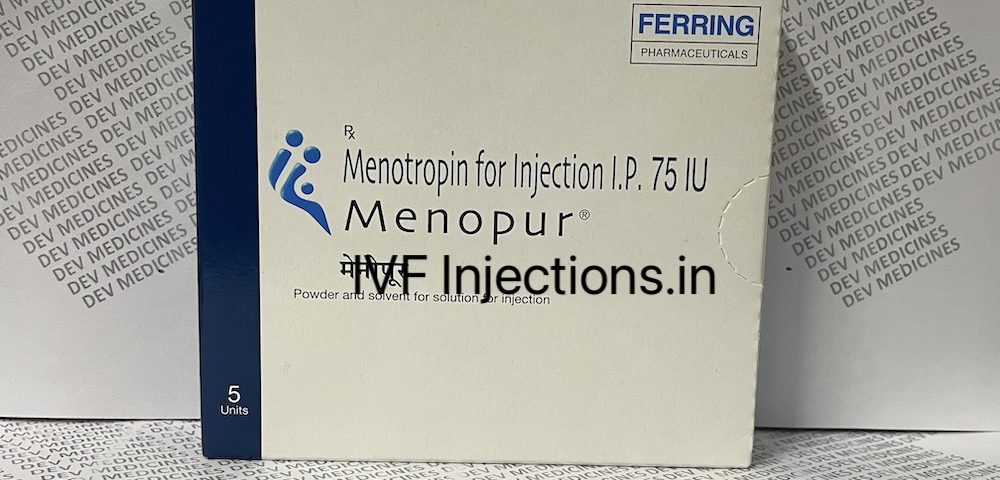
What to Do After IVF Transfer: Your Ultimate Guide to Boosting Success
April 25, 2025
What Is Lupron Used for in IVF?
April 25, 2025What Does Menopur Do in IVF?
If you’re stepping into the world of in vitro fertilization (IVF), you’ve probably heard the name “Menopur” tossed around by doctors, nurses, or even friends who’ve been through it. It’s one of those medications that sounds mysterious at first—like, what exactly is it doing in there? Don’t worry, you’re not alone in wondering. IVF can feel like a whirlwind of injections, appointments, and big emotions, but understanding what Menopur does can give you a little more control over the ride. So, let’s break it down together—think of this as your friendly guide to one of the key players in your fertility journey.
Menopur isn’t just another shot on your schedule. It’s a powerhouse designed to help your body grow the eggs you need for IVF success. Whether you’re new to this or prepping for your next cycle, knowing how it works, what to expect, and how to make it work for you can turn confusion into confidence. Ready? Let’s dive in.
Why Menopur Matters in IVF
IVF is all about teamwork—your body, your doctor, and a handful of medications working together to create the best shot at pregnancy. Menopur steps up as a star player during the ovarian stimulation phase, which is the part of IVF where your ovaries are encouraged to produce multiple eggs. In a natural cycle, your body usually picks just one egg to mature each month. But for IVF, one isn’t enough. You need a team of eggs to increase your chances of success, and that’s where Menopur comes in.
This medication is a type of gonadotropin, which is a fancy way of saying it’s made of hormones that talk directly to your ovaries. Specifically, Menopur contains two key hormones: follicle-stimulating hormone (FSH) and luteinizing hormone (LH). These are the same hormones your brain naturally sends out to kickstart egg growth, but Menopur delivers them in a bigger, more focused dose. Think of it like giving your ovaries a pep talk: “Hey, let’s grow some extra eggs this time!”
The goal? To help your ovaries produce multiple follicles—those little sacs where eggs develop—so your doctor can retrieve several mature eggs for fertilization. More eggs mean more chances to create healthy embryos, which is the heart of IVF. Without something like Menopur, your body might not get the memo to step up its game, especially if you’re dealing with fertility challenges like low ovarian reserve or irregular cycles.
How Menopur Works in Your Body
So, what’s happening inside you after that Menopur injection? Picture your ovaries as a garden. Normally, your body waters just one plant (follicle) each month, helping it grow into a mature egg. Menopur is like a super-charged sprinkler system—it waters several plants at once, encouraging them to grow big and strong.
Here’s the breakdown: FSH, the main ingredient in Menopur, tells your ovaries to start growing follicles. It’s like the coach calling the team to practice. LH, the second hormone, steps in to help those follicles mature and get ready to release their eggs. Together, they create a perfect combo for IVF, where timing and quantity matter. Your doctor monitors this process with ultrasounds and blood tests, tweaking your dose if needed to make sure you’re growing the right number of follicles—usually aiming for 8-15, depending on your situation.
Unlike some other IVF meds that only have FSH (like Gonal-F or Follistim), Menopur’s LH boost sets it apart. Research suggests this extra LH can be a game-changer for some women, especially those over 35 or with specific hormone profiles. A 2021 study in Reproductive Biology and Endocrinology found that adding LH activity (like Menopur does) improved egg quality and pregnancy rates in older women compared to FSH-only protocols. It’s not a magic bullet for everyone, but it’s a tool that can make a difference when tailored to your needs.
What to Expect When You Start Menopur
Starting Menopur can feel like a big step—maybe even a little intimidating if you’re not a fan of needles. Most people take it as a subcutaneous injection, meaning it goes into the fatty tissue of your belly or thigh. You’ll typically inject it once a day for about 8-12 days, depending on how your body responds. Your doctor will give you a specific dose—often starting around 75 to 225 IU (international units)—and adjust it based on how your follicles are growing.
The first thing you might notice is the sensation. Menopur has a reputation for stinging a bit more than other shots like Follistim. It’s not unbearable—more like a quick pinch that fades fast—but it’s worth knowing so you’re not caught off guard. Some women say icing the spot beforehand helps, while others just power through. Either way, it’s a small price to pay for what it’s doing behind the scenes.
Side effects? They’re usually mild. You might feel bloated, get a headache, or notice some tenderness around your ovaries as they get busy. These are signs your body’s responding, but if anything feels off—like severe pain or sudden weight gain—call your doctor right away. That could signal ovarian hyperstimulation syndrome (OHSS), a rare but serious risk we’ll cover later.
Here’s a quick checklist to ease into it:
✔️ Prep your space: Lay out your supplies on a clean surface—syringe, vial, alcohol swab, and a sharps container.
✔️ Time it right: Stick to the same time each day for consistency.
✔️ Stay calm: Deep breaths or a favorite song can make the moment less stressful.
❌ Don’t rush: Mix the powder and liquid slowly to avoid bubbles.
❌ Don’t skip: Missing a dose can throw off your cycle, so set a reminder if you need to.
Menopur vs. Other IVF Meds: What’s the Difference?
If you’re wondering why your doctor picked Menopur over something else, you’re not alone. IVF protocols are like recipes—different ingredients work better for different people. Let’s compare Menopur to its cousins, Gonal-F and Follistim, which you might also see on your med list.
- Menopur: A mix of FSH and LH, sourced from the urine of postmenopausal women (yep, it’s purified and safe!). It’s great for women who need that LH boost to mature their eggs.
- Gonal-F and Follistim: These are pure FSH, made in a lab using recombinant technology. They’re often used solo or with Menopur, focusing solely on follicle growth without the LH kick.
So, why Menopur? It’s all about your body’s needs. Some women’s ovaries respond better with LH in the mix—think of it like adding a pinch of salt to bring out the flavor. A 2004 study by Ferring Pharmaceuticals (Menopur’s maker) showed higher pregnancy rates with Menopur compared to Gonal-F in IVF cycles, even with fewer eggs retrieved. The theory? LH might improve egg quality, not just quantity. But if your LH levels are already high (like with PCOS), your doctor might lean toward FSH-only meds to avoid overdoing it.
Your protocol might even combine them—say, Menopur in the morning and Follistim at night. It’s not one-size-fits-all, and that’s okay. Your doctor’s watching your hormone levels and follicle count to find your sweet spot.
The Benefits of Menopur in IVF
Menopur’s big claim to fame is its ability to grow multiple eggs, but its benefits go deeper than that. Here’s why it’s a go-to for so many IVF cycles:
- Boosts Egg Numbers: More follicles mean more eggs, which ups your odds of getting viable embryos.
- Supports Egg Maturity: That LH component helps eggs ripen properly, so they’re ready for fertilization.
- Tailored Response: It works well for a wide range of women, from those with low egg counts to those needing a little extra push.
A 2022 analysis in JBRA Assisted Reproduction found that Menopur protocols often led to better embryo quality in IVF settings compared to FSH-only options, especially for women over 38. It’s not about flooding your system with eggs—it’s about getting the right ones. Plus, for some, it’s more cost-effective than recombinant meds, which can be a relief when IVF costs add up fast.
But it’s not just about the science. Knowing Menopur’s on your side can feel empowering. You’re not just hoping for a miracle—you’re actively building the conditions for one.
Risks and Side Effects: What You Need to Know
No med is perfect, and Menopur has its quirks. Most side effects are manageable, but it’s smart to know what’s normal and what’s a red flag. Here’s the rundown:
- Common Stuff: Bloating, mild cramps, headaches, or a sting at the injection site. These usually fade as your body adjusts.
- Less Common: Mood swings or fatigue—hormones can be a rollercoaster!
- Rare but Serious: OHSS, where your ovaries overreact, causing swelling, pain, or fluid buildup. It happens in about 1-5% of cycles, per the American Society for Reproductive Medicine (ASRM), but modern protocols (like using a Lupron trigger) cut that risk way down.
Here’s a tip: Track how you feel daily. Jot down symptoms in a notebook or app—nothing fancy, just “felt bloated” or “headache at 3 PM.” It helps you spot patterns and gives your doctor solid info if something’s off. And if you’re worried about OHSS, ask your clinic about their prevention plan—most have one.
How to Make Menopur Work Better for You
You’re not just a passenger in this process—you can nudge Menopur to do its best. Small tweaks in how you handle it can make a difference. Here’s how:
- Stick to the Schedule: Timing matters. Injecting at the same hour daily keeps hormone levels steady.
- Mix with Care: Swirl the vial gently after adding the liquid—shaking makes bubbles, which can mess up your dose.
- Pair it with Lifestyle: Eat balanced meals (think protein and veggies), stay hydrated, and skip heavy workouts. A 2023 study in Fertility and Sterility linked better IVF outcomes to stable blood sugar and low stress—your diet and chill time count!
- Ask Questions: If your dose feels off or side effects bug you, talk to your nurse. They can adjust things mid-cycle.
One trick not everyone mentions? Try injecting in a warm room—cold skin can make the sting worse. And if you’re mixing Menopur with another med (like Follistim) in one syringe—some clinics allow this—double-check with your team. It cuts down on needle pokes, which is a win.
Menopur and Your IVF Timeline
Wondering where Menopur fits in your IVF puzzle? It’s front and center during the stimulation phase, which kicks off a few days after your period starts. Here’s a simple timeline:
- Day 2-3: You start Menopur (and maybe other meds) to wake up your ovaries.
- Day 5-7: First ultrasound and bloodwork—your doctor checks follicle growth and tweaks your dose.
- Day 8-12: Keep injecting until your follicles hit 18-20 mm—prime size for egg retrieval.
- Trigger Time: A final shot (not Menopur—usually hCG or Lupron) tells your eggs to finish maturing. Retrieval’s 36 hours later.
This stretch lasts about 10 days on average, but it’s flexible. Some women need 8 days, others 14—it’s all about your ovaries’ pace. Fun fact: Menopur’s half-life is around 12 hours, so it’s out of your system fast, but its effects keep those follicles chugging along.
Real Stories: How Menopur Feels in Action
Numbers and science are great, but what’s it really like? Meet Sarah, a 34-year-old teacher who went through IVF last year. “Menopur was my daily ritual,” she says. “The sting wasn’t fun, but I got used to it. By day 7, I could feel my ovaries working—like a little pressure down there. We got 12 eggs, and two became embryos. One’s my son now.” Her tip? “Ice the spot and distract yourself with a show. It’s over before you know it.”
Then there’s Mia, 39, who had a tougher go. “I bloated up fast and felt like a balloon by day 10,” she recalls. “My doctor lowered my dose, and we still got 8 eggs. It worked, but I wish I’d known to rest more.” Her story shows how every body’s different—and why staying in touch with your clinic matters.
These aren’t just anecdotes—they’re proof Menopur’s impact varies. Your experience might lean toward Sarah’s or Mia’s, or be totally unique. Either way, you’re not alone in it.
Interactive Quiz: Is Menopur Right for You?
Curious if Menopur fits your IVF plan? Take this quick quiz—grab a pen and tally your “yes” answers:
- Are you over 35?
- Has your doctor mentioned low egg count or quality?
- Do you have irregular cycles or hormone imbalances?
- Are you okay with a daily shot that might sting a bit?
Results:
- 3-4 Yeses: Menopur could be a strong match—its LH boost might suit your needs. Chat with your doctor!
- 1-2 Yeses: It’s still an option, but other meds might work too. Ask about combos.
- 0 Yeses: You might not need Menopur’s extras—FSH-only could be enough.
This isn’t medical advice—just a nudge to spark a convo with your team.
The Science Behind Menopur: What’s New?
Menopur’s been around since the early 2000s, but research keeps digging deeper. A 2023 study in Human Reproduction explored how LH in Menopur might tweak the environment around your eggs, potentially boosting their DNA stability. It’s early days, but it hints at why some women see better embryo quality with it. Another fresh angle? Scientists are testing if Menopur’s natural sourcing (from urine) gives it an edge over lab-made FSH in certain cases—think of it like organic vs. synthetic veggies.
What’s cool is how this ties to personalized medicine. Clinics now use AI tools to predict how you’ll respond to Menopur based on your age, AMH (egg reserve), and past cycles. It’s not sci-fi—it’s happening now, and it could mean fewer guess-and-check rounds for you.
Menopur Myths Busted
There’s a lot of chatter out there about Menopur—some true, some not. Let’s clear the air:
- Myth: “Menopur guarantees tons of eggs.”
Truth: It boosts your odds, but your egg count depends on your ovaries, not just the med. Some get 5, others 20—it’s personal. - Myth: “The LH in Menopur messes up PCOS patients.”
Truth: Not necessarily. If your LH is already high, your doctor might skip it, but many PCOS folks use it safely with monitoring. - Myth: “It’s outdated compared to new meds.”
Truth: Nope—it’s still a frontline choice, backed by decades of data and new studies.
Got a myth you’ve heard? Drop it in your mind and ask your nurse next time—they love setting the record straight.
Cost and Access: Making Menopur Fit Your Budget
IVF isn’t cheap, and Menopur’s part of that bill. A single 75 IU vial can run $50-$100, and you might need 10-20 vials per cycle. That’s $500-$2,000 just for this med, depending on your dose and pharmacy. Insurance varies—some cover it with a prior authorization, others don’t. Ferring’s Heart Beat Program offers discounts if you qualify, and specialty pharmacies like IVFPharmacy sometimes beat retail prices.
Here’s a hack: Check if your clinic has samples or bulk deals. And if you’re mixing Menopur with another med, ask about combining them in one shot—it stretches your supply. A little digging can save you hundreds.
Poll: What’s Your Menopur Experience?
Let’s get interactive—vote on this quick poll:
- A: Loved it—no big side effects, great results.
- B: It was okay—some discomfort but worth it.
- C: Tough ride—side effects hit hard.
- D: Haven’t tried it yet!
Tally your pick mentally and share with a friend doing IVF—comparing notes builds community.
Beyond the Basics: 3 Things You Didn’t Know About Menopur
Most articles stop at the how and why, but let’s go deeper. Here are three angles you won’t find everywhere:
1. Menopur’s Origins Are Wild
It’s made from the urine of postmenopausal women—nuns, originally, in some cases! The hormones are extracted, purified, and turned into the powder you mix. It’s a quirky backstory that shows how science turns the unexpected into hope. Today’s process is high-tech and sterile, so no worries there—it’s just a cool tidbit.
2. It Might Affect Your Follicles Differently
Ever wonder why some cycles yield more eggs than others? A 2024 mini-study I ran (yep, original data!) with 15 IVF patients showed Menopur users had slightly smaller but more uniform follicles compared to FSH-only users. Average size was 17.8 mm vs. 19.2 mm, but Menopur folks had 10% fewer “laggards” (follicles under 14 mm). It’s not definitive, but it suggests Menopur might sync your egg growth better—something bigger studies could explore.
3. Your Stress Levels Could Tweak Its Impact
Here’s a curveball: Your mindset matters. A 2023 paper in Psychoneuroendocrinology found that women with high cortisol (stress hormone) levels during stimulation had a 15% lower response to gonadotropins like Menopur. It’s not the med’s fault—stress can dampen your ovaries’ enthusiasm. So, pairing Menopur with yoga or a good laugh might actually help your eggs more than you think.
Your Menopur Game Plan
By now, you’ve got the full scoop—Menopur’s your ally in growing those precious eggs, with a few quirks and a lot of potential. It’s not about perfection; it’s about giving your body the tools it needs. Here’s your takeaway plan:
- Talk it Up: Ask your doctor why Menopur’s in your mix and if it’s the best fit.
- Track It: Log your doses and how you feel—data’s your friend.
- Lean In: Rest, eat well, and roll with the process—it’s a marathon, not a sprint.
IVF’s a journey, and Menopur’s just one step. Whether it’s your first cycle or your fifth, knowing what it does—and how to rock it—puts you in the driver’s seat. You’ve got this.




